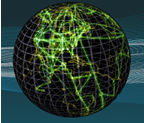October 13, 2006
Laurie Anderson with neuroscientist Antonio Damasio

Live Webcast
Live Webcast of conversation with artist Laurie Anderson and neuroscientist Antonio Damasio, moderated by Professor Anne Balsamo, following a lecture by Anderson :; Saturday, October 21st, 8 p.m. (PDT) at USC's Norris Theater and simulcast FREE at HASTAC website.
Laurie Anderson: Recent Works :: Saturday, October 21st :: University of Southern California's Norris Theater :: 7 p.m. (PDT) :: Free and open to the public!
Laurie Anderson will present a special audio-visual lecture exploring the intersections of art, science and creativity. One of the permier perfromance artists in the world, Ms. Anderson has consistently intrigued, entertained and challenged audiences with her multimedia persentations. Anderson's artistic career has cast her in roles as various as visual artist, composer, poet, photographer, filmmaker, ventriloquist, electronics whiz, vocalist and instrumentalist. Following her presentation, Ms. Anderson will be joined in conversation by neuroscientist Antonio Damasio, director of the USC Brain and Creativity Institute and a leading researcher of cognition, emotions, and neural
systems.
This special presentation is part of the HASTAC In|Formation Year, devoted to twelve months of public programming from a number of universities meant to promote the human and humane dimenstions of technology and to encourage conversation and exchange between humanists, artists, technologists, and scientists.
Recognized worldwide as a leader in the groundbreaking use of technology in the arts, Ms. Anderson has collaborated with Interval Research Corporation, a research and development laboratory founded by Paul Allen and David Liddle, in the exploration of new creative tools, including the Talking Stick. Anderson has produced numerous albums and touring shows and has worked with artists and performers as diverse as William Burroughs, Arto Lindsay, Andy Kaufman, Ian Ritchie, Peter Gabriel, Perry Hoberman, David Sylvian, Jean Michel Jarre, Brian Eno, Nona Hendryx, Bobby McFerrin, Dave Stewart, Hector Zazou, and Lou Reed. She wrote the entry about New York for Encyclopedia Britannica, hosted the PBS special Art 21, and received the 2001 Tenco Prize for Songwriting in San Remo, Italy and the 2001 Deutsche Schallplatten Prize for Life on a String. Currently, Ms. Anderson is touring a new solo work begun during her tenure as the first artist-in-residence of NASA in 2003-2004. Other recent projects included a new commission for the World Expo 2005 in Japan and benefit performances on behalf of Hurricane Katrina victims.
Professor Damasio is a leading neuroscientist. His research interests are directed at the neural basis of cognition and behavior at large-scale systems level. The work is based on MR lesion method, PET/fMRI, and histological mapping of neuropathological tissue. Major contributions include:
(1) the elucidation of cortical and subcortical contributions to face and object recognition;
(2) the identification of specific neural sites involved in emotion processing;
(3) the demonstration that emotion is covertly implicated in decision-making; and
(4) the identification of limbic and brainstem sites of pathology in Alzheimer's disease.
Until earlier 2005, Antonio Damasio was at the University of Iowa as Van Allen Distinguished Professor and Head of the Department of Neurology. Damasio's books, Descartes' Error (1994), The Feeling of What Happens (1999), and Looking for Spinoza (2003), are translated in numerous languages and taught in universities worldwide. He is also the recipient of numerous awards (including, most recently, the 2005 Asturias Prize in Science and Technology; and the 2004 Signoret Prize, which he shared with his wife, Hanna Damasio). Damasio is a member of the Institute of Medicine of the National Academy of Sciences and a fellow of the American Academy of Arts and Sciences, the Bavarian Academy of Sciences, and the European Academy of Sciences and Arts. He has been named "Highly Cited Researcher" by the Institute for Scientific Information.
Professor Anne Balsamo is the Director of the Institute for Multimedia Literacy at the University of Southern California. She previously served as the Associate Director of the Stanford Humanities Lab and is a founding partner of Onomy Labs, a Silicon Valley-based technology design firm. She has faculty affiliations with Stanford University's Center for Design Research and its Feminist Studies Program. Until 2001, she was a principal scientist and a member of RED (Research on Experimental Documents) at Xerox PARC, where she did collaborative research on experimental documents and new media genres. She served as project manager and new media designer for the development of RED's touring museum exhibit, "XFR: Experiments in the Future of Reading." Her first book, Technologies of the Gendered Body: Reading Cyborg Women (Duke, 1996) investigated the social and cultural implications of emergent bio-technologies. She is currently working on a new book entitled Designing Culture: A Work of the Technological Imagination, which examines the relationship between cultural theory and the design of new media. She is a founding member of HASTAC.
This event is made possible by the USC School of Cinema-Television, the Institute for Multimedia Literacy, the USC Arts and Humanities Initiative, MOCA, and the Annenberg Center for Communication, among others. For more information, see http://www-cntv.usc.edu/resources/events/events.cfm
Posted by jo at October 13, 2006 01:44 PM
